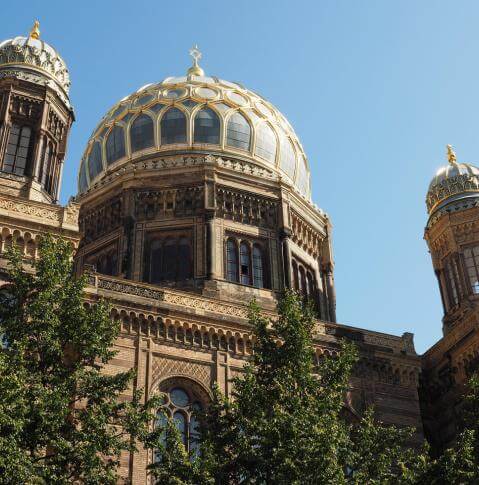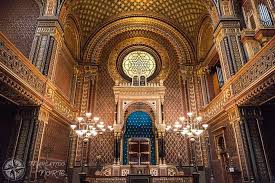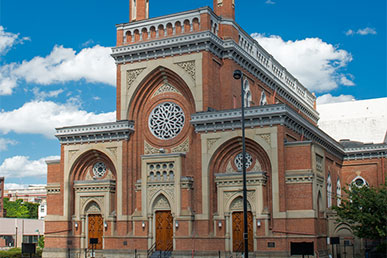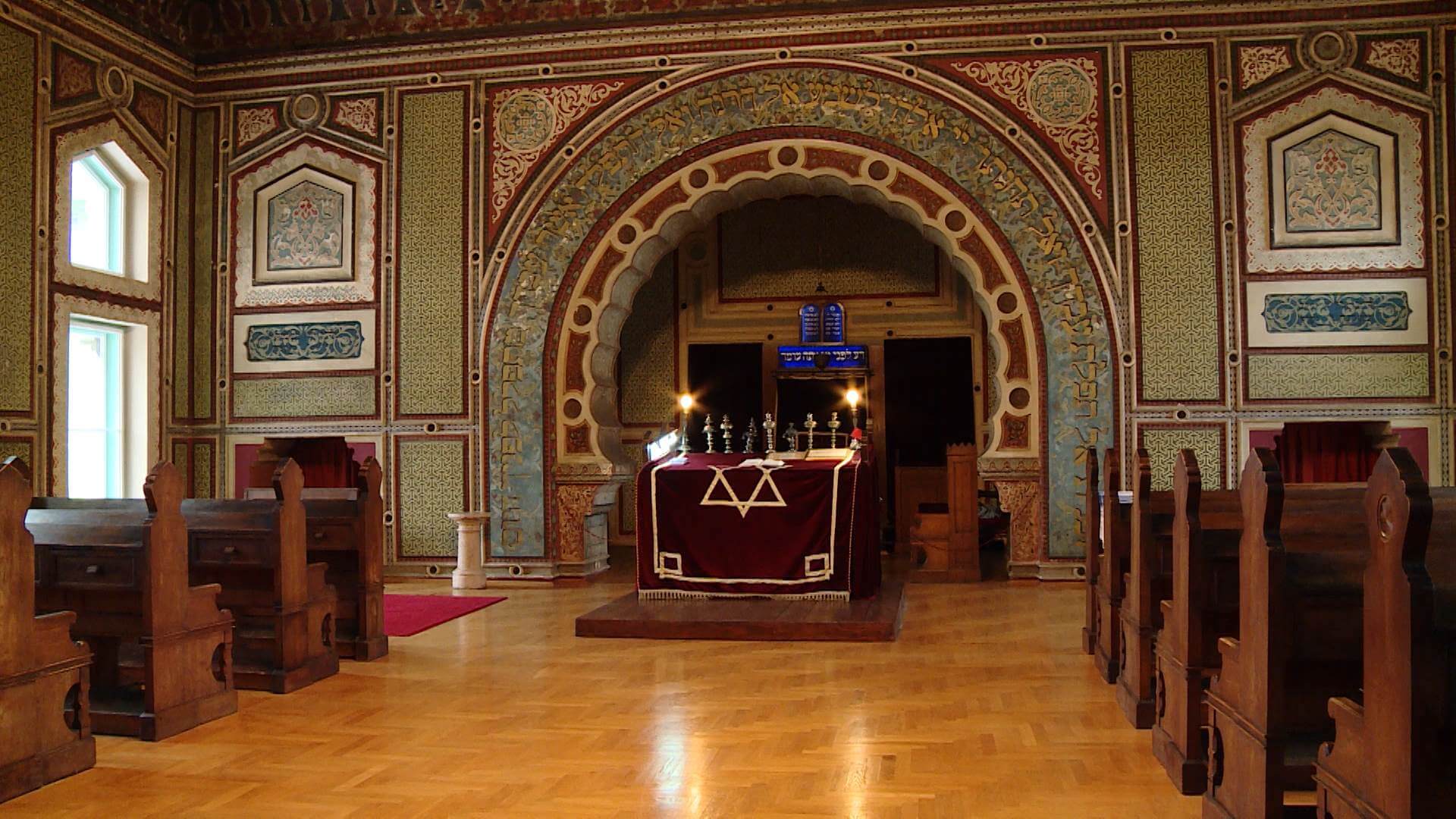It is an astonishing fact that many Jewish synagogues across Europe and America from the early 19th century onwards were built in the intricate and visually striking Islamic Neo-Moorish (Neo-Andalusian) architectural style.
According to the online magazine "Mogulesque," the practice signified the Jewish community's embrace of Islamic architecture. This was prevalent not just in large cities like Berlin, New York, Prague and Vienna, but also in smaller ones like Sarajevo, Corsicana, Texas, Owensboro, Kentucky, and Quincy, Illinois.
The majority of elements from the vocabulary of Islamic architecture, particularly Neo-Moorish aesthetics, were adopted. What stands out are the horseshoe arches, muqarnas, arabesques, mihrab-like niches, ablaq techniques, merlon crenellations, minarets, iwans, pendentive domes, Nasrid column capitals, and sculpted plaster elements showcasing elaborate, lace-patterned artistry. The only component that is entirely missing is the Arabic-Islamic spiritual calligraphy, which, as one would expect, was replaced with religious Hebrew inscriptions and other purely Jewish symbols.
If the out-and-out Hebrew inscriptions and Jewish symbols are removed from any of such synagogues, nobody would be able to guess that it is a synagogue. Rather, a person would think that it is a segment of the vast and heterogeneous universe of the Islamic built environment.
There are even claims suggesting that Berlin's New Synagogue, which was constructed during the mid-19 th century and serves as the primary place of worship for the Jewish community residing in the city, was deliberately designed to evoke a striking resemblance to the magnificent Alhambra palace and fortress complex that is situated in the historic city of Granada, Spain.

As reported by Carol Krinsky in his book "Synagogues of Europe: Architecture, History, Meaning," Islamic architectural features first appeared prominently in a synagogue in Germany in 1832. This was soon followed by many other synagogues. The interior of the Dresden synagogue featured thin piers and numerous decorative details inspired by illustrations of the Alhambra. This design became well known upon its publication in 1847, and its Moorish interior decoration was adopted in many other synagogues later, including Berlin's New Synagogue.
To Carol Krinsky, Islamic architectural forms were used more frequently and abundantly in synagogue architecture than Byzantine designs.
"Many synagogues had horseshoe arches that could be round or pointed, cusped or smooth. There were polychromed wall patterns taken from engravings of mosques or palaces. Inscriptions could be integrated with the ornament, which avoided all figural representation. Slender cast-iron piers imitated the delicate supports of the Alhambra and, being slender, they did not obstruct sight lines. A bulbous dome might rise over the ark, or over turrets that resembled minarets. If a crenellated horizontal cornice rose higher in the center than on the sides of a facade it evoked not only reconstructions of Solomon's Temple, but also mosque or Islamic palace facades and the porch and wall composition in the Patio of the Lions at the Alhambra."

The same author went so far as to assert that certain synagogues were constructed in such a manner that they bore an astonishing resemblance to Islamic architecture, to the point where one could say that the only missing element was "the crescent at the summit." In other words, these synagogues, designed in the Islamic style, were nearly indistinguishable from Islamic structures, particularly mosques, showcasing a remarkable similarity in their design and aesthetic (Carol Krinsky, Synagogues of Europe: Architecture, History, Meaning).
Moreover, the Spanish Synagogue in Prague, Czech Republic, completed in 1868, is on par with any Neo-Moorish masterpiece built not only by non-Muslims, but as well by Muslims themselves. This applies to both the building's interior and exterior. Its successive, multi-leveled horseshoe arched windows remind one of the forest of horseshoe arches in the Great Mosque of Cordoba, some of which are two-tiered.

The synagogue's interior, especially the bimah - the raised platform at the front of the sanctuary - is so delicately executed and embellished that it calls to mind the architectural and artistic brilliance of the mihrab (praying niche) area of Cordoba's Mosque, as well as the deepest recesses of the Alhambra.
Just two years before the Spanish Synagogue in Prague, in 1866, the Isaac M. Wise Temple was built as a historic Reform Jewish congregation and synagogue located in Cincinnati, Ohio, in the United States. Unlike most synagogues, this one features two minarets flanking the central and significantly elevated part of the front façade, just above the main portal, resembling an iwan and marking the beginning of the building's central aisle.
As such, the building's front façade resembles the Amir Chakhmaq Mosque Complex in Yazd, Iran. As strange as it may seem, anyone seeing this synagogue for the first time is likely to mistake it for a mosque.
When the Sarajevo Synagogue was built in 1902, it also followed the specifications of the Neo-Moorish architectural style. However, in line with the architectural preferences of the Austro-Hungarian regime and its "mission to civilize" Bosnia, the Neo-Moorish style was diversified and further enriched with elements of the Neo-Mamluk style.

This reflected the Austro-Hungarian occupiers' obsession with streamlining and controlling the diverse, multireligious Bosnian society, using architecture as a powerful tool. Consequently, the Sarajevo Synagogue, especially from the inside, appears to an observant eye as a finely built and lavishly veneered Muslim palace reminiscent of those in Istanbul, Cairo, or Spain (al-Andalus).
At least three factors contributed to the Jewish espousal of Islamic architectural influences.
Hence, the late 18 th century marked the rise of Romanticism as a prominent artistic and intellectual movement in Western culture. The overarching goal of the movement was to champion the significance of personal subjectivity, the power of imagination, and a heartfelt appreciation for the wonders of nature in shaping the fabric of society and cultural expression.
"Romanticism can be seen as a rejection of the precepts of order, calm, harmony, balance, idealization and rationality that typified Classicism in general and late 18th-century Neoclassicism in particular. It was also to some extent a reaction against the Enlightenment and against 18th-century rationalism and physical materialism in general. Romanticism emphasized the individual, the subjective, the irrational, the imaginative, the personal, the spontaneous, the emotional, the visionary and the transcendental" (Romanticism, Encyclopedia Britannica).
Romanticism aimed to create more open, diverse, and enriching intellectual and cultural environments than those offered by the progressively rigid and dogmatic Weltanschauung of Western civilization. Therefore, as part of the evolutionary trajectory of Romanticism, the movement was eager to embrace the variety of ideas and emotional perspectives arising from the distortion and construction, followed by the gradual importation and imitation, of images from the Eastern world (the Orient) (Edward Said, Orientalism).
One of the immediate targets was the remnants of the remarkable cultural and civilizational legacy of Muslim Spain, with the architectural dimension standing at the forefront due to its being a ubiquitous form of art for the people. As a result, the Neo-Moorish architectural style was popularized, quickly becoming fashionable. It became an embodiment of the "exotic Orient," serving as a means to express fantasy, dreams and mystery.
The same period witnessed numerous political changes throughout Europe resulting in the Jews being granted more freedoms and rights. They were allowed to leave their ghettos, apply for jobs previously unattainable, and build large communal structures, such as synagogues (Emily Jelen, Moorish Revival Synagogue Architecture).
Having witnessed the latest cultural trends in the West, the Jews, in order to quickly position themselves favorably and attract positive attention, adopted the Neo-Moorish aesthetic style for their synagogues. They wanted to demonstrate that they were not only different from the rest of the West, but also connected to the "magical and prized" Orient.
It was not difficult for the Jews to realize that the best and fastest way to assert their Oriental status was to align themselves with Muslims, their younger Semitic brothers and, until recently, the global cultural and civilizational masters under whose aegis the Jews could also live freely and equally. The move was a kind of shortcut to exposure and reverence. It was an attempt to achieve recognition by association.
Doing so represented a harking back to the Golden Age of Muslim Spain, when the Jews were respected alongside Christians and Muslims throughout society at all levels (Diana Darke, Stealing from the Saracens: How Islamic Architecture Shaped Europe). The Neo-Moorish architectural style, therefore, became the preferred choice for synagogue architecture so as to preserve a legacy and create a point of reference. It was also intended to generate a culture of remembrance and perhaps function as a source of inspiration for the future.
The age of Muslim Spain was the only time when the Jewish community could prosper and envision a sustainable future. The case of the Sephardic Jews (the Jews of Spain) under Muslim rule has become the stuff of legend. Inspired and guided by the teachings and values of Islam, the Jews were treated fairly by Muslims and were given all the opportunities necessary for personal and community development. They were regarded as equal citizens and partners in the advancement and management of the state.
Naturally, the Jews, who had known only humiliation and persecution, seized the opportunity and advanced through the ranks of Muslim civilization. They responded by living as law-abiding, cooperative and productive members of society. For this reason, the age of Muslim Spain was regarded by the Jewish diaspora as their only Golden Age.
Building later their synagogues in the Neo-Moorish style had a dual significance: it served to commemorate and celebrate the identity of the Sephardic Jew, while also using that identity-linked to integration, resilience and progress-as a foundation for potential modern integration, resilience and progress in response to rising Western antisemitism.
Additionally, it expressed sorrow and indirectly criticized Western powers for their antisemitic behaviors.
Their biological survival prospects and collective socio-cultural performances faced a constant decline. Institutionalized antisemitism became ingrained in the cultures of Western nations. Not being antisemitic was an anomaly for both individuals and communities. Even if there were exceptions, they in no way invalidated the general trend.
Partly fortuitously and partly by design, in the 19 th century, the Jews started to experience more freedom and rights in certain parts of Europe. This development prompted the Jewish people to enhance their organization, resulting in more clearly defined and restructured interests. As a consequence, European Jewish communities were tasked with constructing synagogues that could showcase their newfound freedoms, as well as their history, culture and aspirations. (Emily Jelen, Moorish Revival Synagogue Architecture).
However, as good as they truly were, these developments caught the Jews both off guard and ill-equipped. The material resources and immaterial capacities they possessed could only take them so far in responding to the hitherto unknown challenges. With respect to the global cultural and civilizational exchanges, the Jews had virtually nothing significant to show or offer to the world.
The only time they were in control of their own socio-cultural destiny, and thus were able to become a productive force, was during the Golden Age of Muslim Spain. Whatever they could come up with was, in some way, connected to the Moorish aspects of Islamic civilization.
When the Jews began building synagogues for themselves, favoring the Neo-Moorish architectural style, it reflected both recognition and appreciation, as well as scarcity and dependence. Once completed, these synagogues represented Judaism and the beginnings of contemporary Jewish culture, albeit almost fully cloaked in the transcendent mantle of Islamic civilization, particularly in art and architecture.
The synagogues further exemplified the ideological and historical connection between the two branches of the Semitic tree. They exhibited who the true friends and enemies of the Jews were. The synagogues marked the first steps in the long quest of the Jews for the level of socio-cultural affirmation, with several fundamental elements inspired by Islamic heritage.
Even the ultimate aspirations of the Jews, regardless of how distant they might have been projected, could not be dissociated from Islam and Muslims. Many of those aspirations and Jewish ancient historical memories were linked to Palestine, a holy land for all parties involved.
At that time, Palestine was under Muslim rule; however, it was always regarded as the epicenter of all Abrahamic faiths, with access, peace, security and hospitality guaranteed to all. Though Muslim, Palestine was never an exclusive or inaccessible territory.
Coexistence in Palestine was its reason for being.
Muslims were merely guardians of people and places, as well as freedom, safety, justice and the opportunities associated with them. They did this not for political expediency, but because of existential principles and religious beliefs. Thus, if the Jewish historical legacy was connected to Muslims and their civilizational achievements, so was their future. No matter how one viewed it, the Jews could not escape their associations and interactions with Muslims.
Indeed, the Neo-Moorish synagogues symbolized a bridge between the past and the future, shaped by the dynamic relationships between Muslims and Jews.
In the midst of the storm, the Jews felt increasingly isolated and vulnerable. A natural response was that they too began to dream of their own state, governed exclusively by them as a nation. This sentiment gave rise to Zionism, a Jewish nationalist ideology and movement, whose main objective was to establish a Jewish state in the land of Palestine through the enterprise of bloody colonization.
The initiative only played into the hands of the West. For a long time, driven first by Christianity and later by both Christianity and nationalism, the West has sought to suppress, harm and even eliminate the Jews. In the Zionism project, the West saw an opportunity to resolve its own Jewish problem in a decisive way. Zionism allowed the West to gradually distance itself from the perceived threat of the Jews and, by supporting the establishment of an apartheid system and repressive regime in Israel, to set them against their only friend and ally: Muslims.
Thus, the devilish plans of the West seemed to have a perfect ending. They not only solved the Jewish problem, but also caused serious problems for their next biggest enemy: Islamdom. Like so, the West managed to kill two birds with one stone.
There were many in the Jewish circles who were able to understand this, voicing their disproval for the creation of Israel as an illicit entity within a foreign context. Such a move was bound to divest the Jews of whatever rights and statuses they were able to secure over ages for themselves in countries across the world.
Once a new state of Israel was created, the Jews all over the world will be branded strangers in their own lands, and their hard-won position as citizens and nationals of those lands will be undermined. They will then be required to relinquish what is known and established in exchange for what is uncharted and precarious.
One of those enlightened and able to forecast the future was Edwin Montagu, an influential anti-Zionist Jew and the only Jew in a senior British government position, who wrote a memorandum to the British government in conjunction with the declared British willingness to establish in Palestine a national home for the Jewish people, later resulting in the Balfour Declaration.
In the memorandum, Edwin Montagu was clear that the idea of a Jewish nationhood was anomalous, for "there is not a Jewish nation"; that Palestine was not "associated with the Jews or properly to be regarded as a fit place for them to live in"; and that "when the Jews are told that Palestine is their national home, every country will immediately desire to get rid of its Jewish citizens."
Edwin Montagu titled his memorandum as "On the Anti-Semitism of the Present (British) Government" implying that "the policy of His Majesty's Government is anti-Semitic, (and) in result will prove a rallying ground for anti-Semites in every country in the world."
In short, the formation of Israel was destined to be a mistake, bringing about more harmful effects than beneficial ones for the Jewish population. The fact that Israel exists clearly shows that the Western powers have taken on the role of implacable enemies, whose continuous antagonism has regrettably caused the Jews to lose whatever few positive options they had.
One can easily see that while today the whole normal world is calling for an end to the Gaza genocide and is seeking a suitable solution, the West insists on prolonging the tragedy. They are the only ones who push for more violence, more bloodshed, and more animosity between the Jews and Muslims.
The more the Jews and Muslims suffer, the better it is for the West.
If the two could only bleed each other to utter destruction, that would be the most ideal scenario for the West.